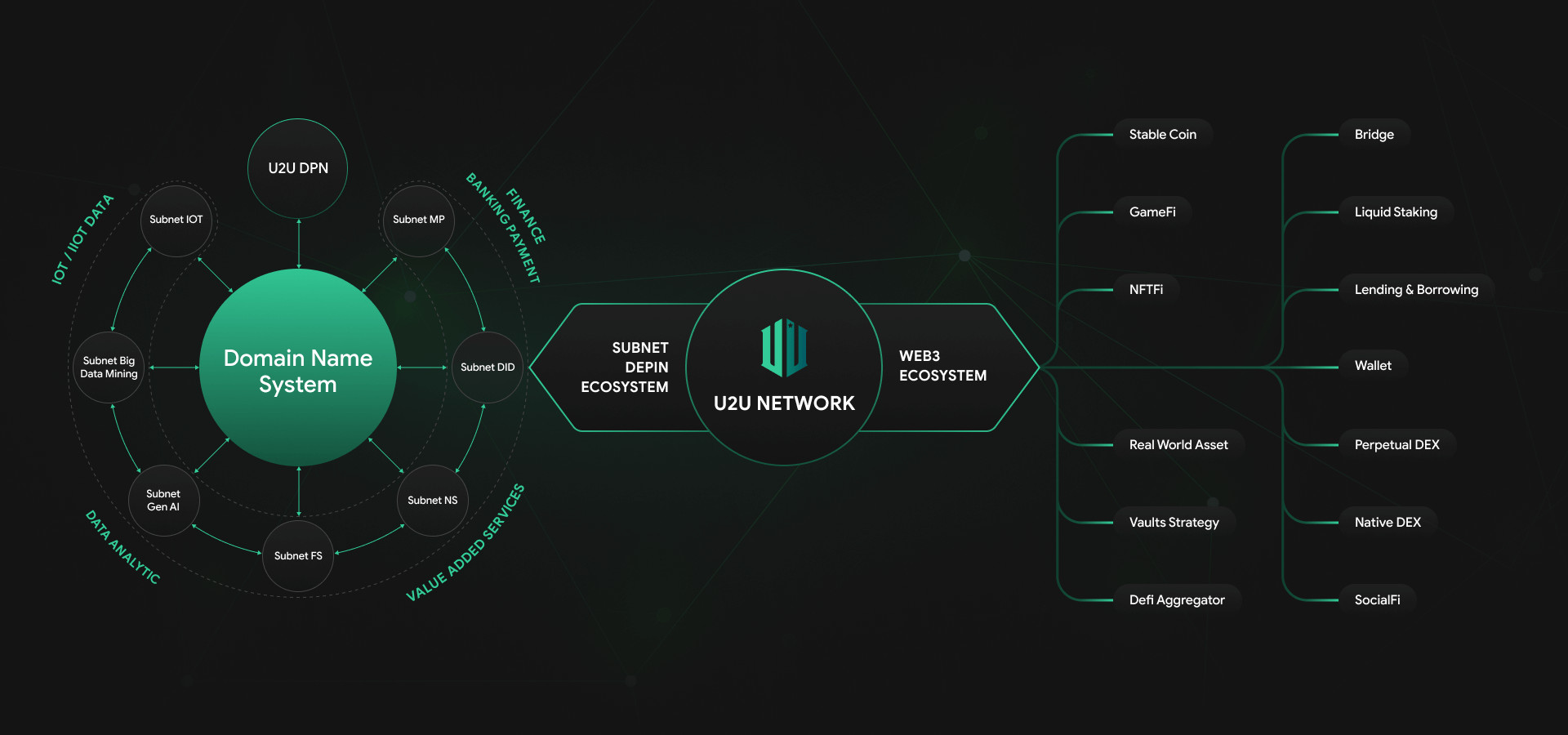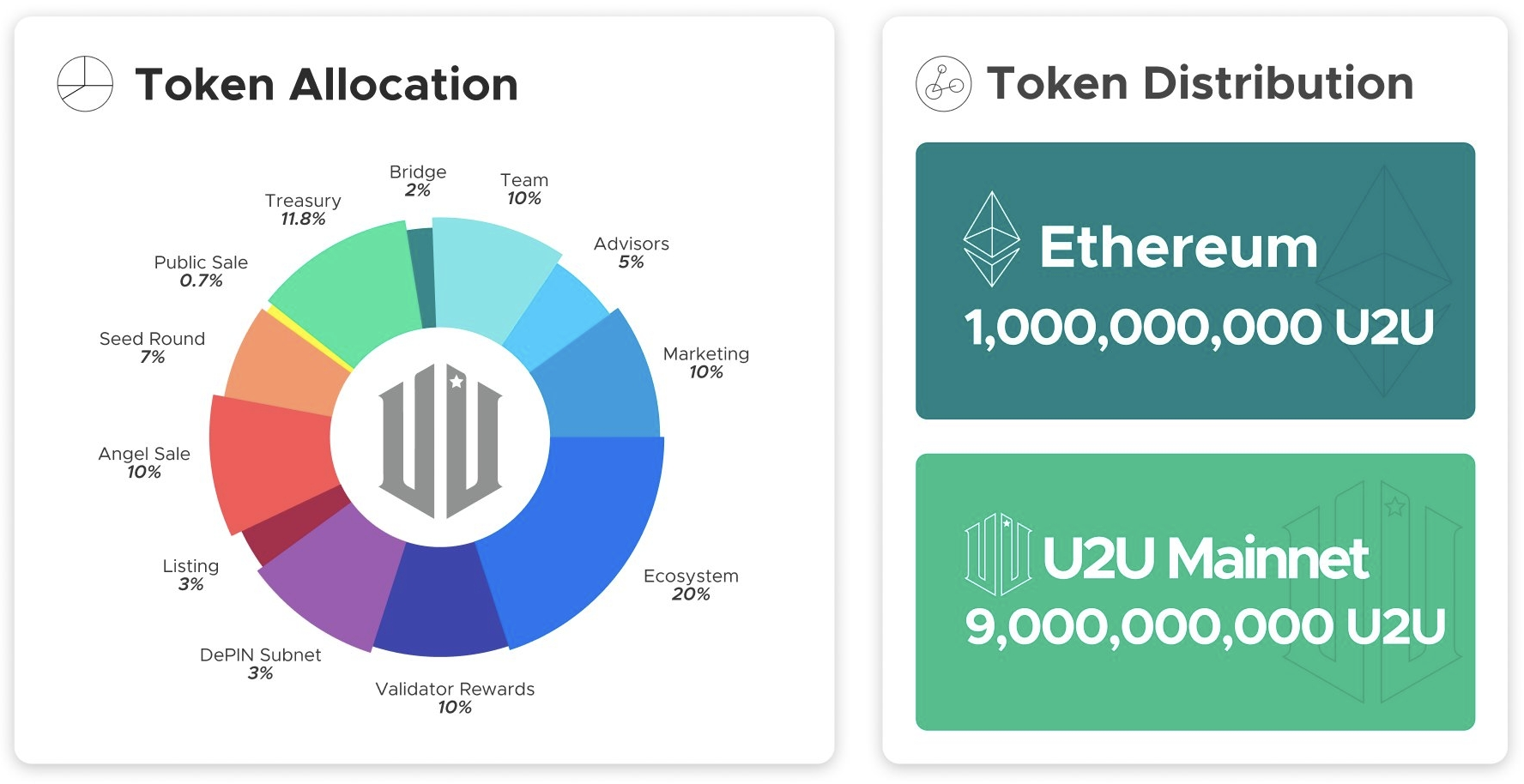The blockchain industry continues to evolve, with new Layer-1 solutions challenging established giants like Ethereum. For developers, investors, and enthusiasts exploring scalable and efficient blockchain networks, comparing U2U Network with Ethereum is essential to understand their unique strengths, use cases, and technological differences. This article provides an in-depth comparison of U2U Network and Ethereum, focusing on architecture, performance, scalability, and ecosystem potential, ensuring you have the insights needed to make informed decisions.
What is U2U Network?
U2U Network is a modular Layer-1 blockchain designed for high scalability, low latency, and developer flexibility. Built using Directed Acyclic Graph (DAG) technology and Ethereum Virtual Machine (EVM) compatibility, U2U Network combines the familiarity of Ethereum’s ecosystem with innovative features like its Helios Consensus Protocol and subnet architecture. Tailored for use cases such as Decentralized Physical Infrastructure Networks (DePIN), IoT, and cross-chain applications, U2U Network aims to address the scalability and cost challenges faced by traditional blockchains.
What is Ethereum?
Ethereum is the world’s leading smart contract platform, known for its robust ecosystem, decentralized applications (dApps), and widespread adoption. Since transitioning to Proof of Stake (PoS) in September 2022, Ethereum has prioritized energy efficiency and scalability through Layer-2 solutions like Arbitrum and Optimism, with plans for sharding in future upgrades. Ethereum’s strength lies in its developer community, decentralized finance (DeFi) dominance, and non-fungible token (NFT) marketplaces.

Comparing U2U Network with Ethereum: Key Metrics
When comparing U2U Network with Ethereum, several factors stand out, including architecture, consensus mechanisms, scalability, transaction costs, and interoperability. Below, we break down these aspects to provide a clear picture.
1. Architecture and Technology
U2U Network:
- DAG-Based Structure: Unlike traditional blockchains, U2U uses a DAG architecture, enabling parallel transaction processing. This reduces bottlenecks and enhances throughput, making it ideal for high-demand applications.
- Subnet Technology: U2U’s modular subnets allow developers to create customized, independent networks that inherit the mainnet’s security. This is particularly valuable for niche use cases like IoT or DePIN.
- EVM Compatibility: Developers can leverage Ethereum’s tools, smart contracts, and dApps, ensuring a smooth transition for Ethereum-based projects.
Ethereum:
- Traditional Blockchain: Ethereum processes transactions sequentially in a linear blockchain, which can lead to congestion during peak usage.
- Layer-2 Scaling: Ethereum relies on rollups (e.g., Optimism, Arbitrum) to offload transactions, improving speed and reducing costs. Sharding, expected in future upgrades, will further enhance scalability.
- Smart Contract Pioneer: Ethereum’s robust smart contract functionality supports a vast ecosystem of dApps, from DeFi to NFTs.
Key Takeaway: U2U Network’s DAG and subnet architecture provide inherent scalability, while Ethereum depends on Layer-2 solutions to address scaling challenges. For developers seeking flexibility, U2U’s modularity is a significant advantage.
2. Consensus Mechanism
U2U Network:
- Utilizes the Helios Consensus Protocol, blending Asynchronous Byzantine Fault Tolerance (aBFT) and Delegated Proof of Stake (DPoS). This ensures high security, decentralization, and a transaction finality time of approximately 650 milliseconds.
- The aBFT component allows U2U to tolerate up to one-third of malicious nodes, ensuring network reliability.
Ethereum:
- Operates on Proof of Stake (PoS) since the Merge, reducing energy consumption by over 99% compared to its previous Proof of Work (PoW) model.
- Transaction finality takes 12–15 seconds under optimal conditions, which is slower than U2U but reliable for a global network.
When comparing U2U Network with Ethereum, U2U’s Helios Consensus offers faster finality, making it suitable for applications requiring near-instant transactions. Ethereum’s PoS prioritizes security and decentralization for its vast ecosystem.
3. Scalability and Performance
U2U Network:
- Capable of processing thousands of transactions per second (TPS) due to its DAG structure and parallel processing.
- Subnets enable tailored scalability, allowing specific use cases to operate independently without congesting the mainnet.
- Low latency (650ms finality) makes U2U ideal for real-time applications like IoT or gaming.
Ethereum:
- Mainnet processes 15–30 TPS, which is limited compared to newer blockchains. Layer-2 solutions like Arbitrum can achieve thousands of TPS, but these require additional infrastructure.
- Future sharding will distribute data across multiple shards, potentially increasing TPS significantly.
- Congestion during high demand can lead to slower transactions and higher fees.
Key Takeaway: U2U Network outperforms Ethereum in raw scalability and speed, particularly for niche applications. Ethereum’s reliance on Layer-2 solutions bridges the gap but adds complexity.
4. Transaction Costs
U2U Network:
- Offers low transaction fees due to its efficient DAG structure and high throughput. This makes it attractive for microtransactions and cost-sensitive applications.
- Subnets further reduce costs by isolating transactions from mainnet congestion.
Ethereum:
- Gas fees on Ethereum’s mainnet can be volatile, often spiking during network congestion (e.g., NFT minting events).
- Layer-2 solutions significantly lower fees, with transactions costing fractions of a cent on rollups like Optimism.
- Future upgrades like sharding aim to reduce costs further.
For cost-conscious developers, U2U Network’s low fees provide a clear edge when comparing U2U Network with Ethereum, especially for high-frequency transactions.
5. Interoperability
U2U Network:
- Integrates the Inter-Ledger Protocol (ILP) for seamless cross-chain communication, enabling asset and data transfers between U2U and other blockchains.
- Subnets can be customized for interoperability with specific ecosystems, enhancing U2U’s versatility.
Ethereum:
- Supports cross-chain interactions via bridges (e.g., Polygon Bridge) and protocols like Polkadot or Cosmos.
- Ethereum’s interoperability is robust but less native compared to U2U’s ILP integration.
U2U Network’s ILP gives it a slight advantage in cross-chain interoperability, making it a strong contender for multi-chain applications.
Ecosystem and Use Cases
U2U Network:
- Focuses on emerging use cases like DePIN, IoT, and real-time applications. Its subnet architecture allows tailored solutions for industries requiring high throughput and low latency.
- EVM compatibility ensures access to Ethereum’s developer tools, fostering rapid dApp development.
- Early-stage ecosystem with growing adoption, particularly in Asia and DePIN-focused projects.
Ethereum:
- Dominates DeFi, NFTs, and Web3 gaming, with over $50 billion in total value locked (TVL) in DeFi protocols as of 2025.
- Hosts thousands of dApps, from Uniswap to OpenSea, supported by a mature developer community.
- Layer-2 ecosystems (e.g., Polygon, Arbitrum) expand Ethereum’s use cases while maintaining mainnet security.
Ethereum’s mature ecosystem is unmatched for DeFi and NFTs, but U2U Network’s focus on DePIN and IoT positions it as a forward-thinking alternative when comparing U2U Network with Ethereum.
Which Blockchain Should You Choose?
Choosing between U2U Network and Ethereum depends on your project’s goals:
Choose U2U Network if you need:
- High scalability and low-latency transactions.
- Modular subnets for customized use cases (e.g., IoT, DePIN).
- Low transaction fees and cross-chain interoperability.
- A future-proof blockchain for emerging technologies.
Choose Ethereum if you prioritize:
- A mature ecosystem with extensive developer support.
- Dominance in DeFi, NFTs, and Web3 applications.
- Security and decentralization backed by a global network.
- Access to Layer-2 solutions for cost-effective scaling.
Comparing U2U Network with Ethereum reveals two powerful Layer-1 blockchains with distinct strengths. U2U Network excels in scalability, low-cost transactions, and modularity, making it ideal for innovative use cases like DePIN and IoT. Ethereum, with its unmatched ecosystem and developer community, remains the go-to platform for DeFi, NFTs, and established dApps. By understanding their differences, developers and investors can choose the blockchain that aligns with their vision, whether it’s building next-gen applications on U2U or leveraging Ethereum’s robust infrastructure.
For the latest updates on U2U Network and Ethereum, stay tuned to blockchain news and explore their official documentation to dive deeper into their capabilities.

